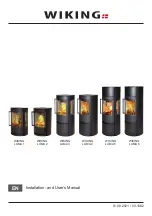
Page 15 of 24 pages
Norsk
Firing manual - wood
Your first heating session
The lacquer will be fully hardened after the stove has been used, and the door and the ashpan
should be opened very carefully as there will otherwise be a risk that the gaskets will stick to
the lacquer. In addition the lacquer may initially give off an unpleasant odour, so make sure
that the room is well ventilated.
Warning:
The accompanying glove may wear the surface paint off. Be careful not to touch
the varnished surfaces the first two to three times you light the fire. Even after the paint has
hardened, repeated use of the glove may wear the surface paint off.
Tips about fuel
Approved fuel types
The wood burning stove is EN approved for combustion of wood only. It is recommended to
use dried chopped wood with a water content of a maximum of 18%. Stoking a fire with wet
wood results in soot, environmental problems, and a less efficient fuel economy.
Recommended wood types
All types of wood, for instance birch, beech, oak, elm, ash, conifers, and fruit trees can be used
as fuel in your insert. The great difference is not in the fuel value, but in the weight of the wood
types per cubic metre.
Beech weighs more per m
3
of wood than common spruce, for instance.
This is why more common spruce is required, in terms of volume, to obtain an amount of heat
similar to that of beech. Heavy types of wood such as ash, beech, oak and elm are generally not
that easy to light up. In addition, they burn more slowly and give off more embers. Light types of
wood such as birch, maple, spruce and pine are more easy to light up. They burn faster and give
off fewer ambers. You may therefore take advantage of the light types of wood for lighting and use
the heavier types of wood to ensure a longer burning time..
Banned fuel types
It is not allowed to stoke a fire with the following: printed matter, plywood, plastic, rubber, fluid
fuels, and rubbish such as milk cartons, lacquered wood or impregnated wood and fossil fuels.
The reason that you should not apply any of the above is that during combustion they develop
substances that are health hazardous and harmful to the environment. These substances
could also damage your wood burning stove and chimney, rendering the product warranty
void.
Storage of wood
A moisture content of 12-18% is achieved by storing recently felled wood outdoors under a
lean-to for at least one year, preferably 2 years. Wood stored indoors has a tendency to be-
come too dry and combust too quickly. However, it might be advantageous to store fuel for
lighting a fire indoors for a few days prior to use.
It is recommended to purchase a wood moisture meter to continuously check that the firewood
has the correct moisture content before using it for firing.
Split the wood and measure the mois-
ture content of the split surfaces.
Recommended dimensions
The dimensions of the fuel are important to good combustion. The dimensions should be as
follows:
Содержание Luma 1
Страница 3: ...Page 3 of 24 pages A1 A2 B1...
Страница 4: ...Page 4 of 24 pages B2...
Страница 5: ...Page 5 of 24 pages E1 E2 C...
Страница 6: ...Page 6 of 24 pages D F...
Страница 7: ...Page 7 of 24 pages G...
























